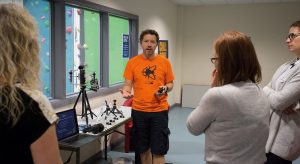Jon Gill from Playful Communications explains how you can use your smart phone to make films…
Camera phones – they’re for taking snaps, right?
And it’s one thing to take pictures, but filmmaking?
Well you’d be right. About the snaps.
Beyond that it’s quite possible that the phone you have in your purse or pocket (or maybe you’re reading this on it) is every bit the filmmaking machine that some Hollywood types believe it to be.
That’s right, Hollywood!
To one degree or another smart phone filmmaking has been around for over a decade. However, in the last five years or so a significant increase in the quality of smart phone cameras has enabled an entirely new era of ‘professional’ filmmaking and storytelling.
In 2015 writer/director Sean Baker made the highly celebrated independent film ‘“Tangerine’”. Keen on spending more money on cast and crew than kit, he opted to shoot using three iPhones.
In 2017 Steven Soderbergh (Oceans 11; Traffic) came out of retirement to make “UnSane” – which he shot on an iPhone.
This was not a flash in the pan as both filmmakers have gone on to use mobile devices on subsequent films, most recently Soderbergh’s “High Flying Bird” in 2019, funded by Netflix.
MoJo
Even if you haven’t seen any of these movies it’s possible you have seen a film made on a mobile on your TV. Journalists across the globe have been making news reports using mobile devices for some time. While the likes of Soderbergh chose a smart phone for a faster, more authentic approach to filmmaking, journalists had significantly more practical reasons. Getting a full film crew in the right place at the right time, can be problematic to say the least. However, one person and a smart phone can capture all of the required footage – including themselves reporting to camera.
Back in Hollywood smartphone films are edited traditionally – meaning all of the shots are transferred to a computer in an editing suite.
However, in the field journalists can edit a full report, complete with titles and voice over, on the same device, on-the-go.
Today, news outlets such as the BBC, Al Jazeera and RTE have journalists sharing news reports daily, on-line and social media, and on TV, captured and edited on a single device. The BBC even has a dedicated mobile journalism (MoJo) trainer.
The fact remains that filmmaking is an expensive business – which is why, historically, only a small number of people did it. In 2020, it’s more accessible than ever with a large percentage of the population, from teenagers upwards, owning the most expensive piece of kit required – the camera – because they have one attached to their phone.
Get Creative
My aim in 2011 was to show young people how creative they could be with devices capable of much more than being tools for browsing the web or playing games. Today that remit extends out to anyone who wants to share their story.
There are hundreds of free (or very cheap) apps that enable inventive and creative filmmakers. Time-lapse, motion blur, motion graphics and fancy titles, colour correction, music creation, animation… all of this and a lot more can be achieved on most smart phones or tablets of the last five years – both Apple and Android.
You can of course augment your device with physical additions – tripods, lenses, microphones, lights, waterproof casings (you’d be suprised), etc, etc.
Equally, you can simply start with what’s built into the phone. And this is where my mobile filmmaking courses come in.
As well as making promotional films and capturing projects for clients I have a learning programme called #MadeOnAMobile – currently in two levels, ‘Take 1’ and ‘Take 2’ – which you can access through CDN.
Click here to register for Made On A Mobile Take 1 on Tuesday 4 February
Click here to register for Made On A Mobile Take 2 on Tuesday 11 February
Who is it for? It’s difficult to narrow down a particular demographic but…essentially it’s for anyone with a story – a product, service or passion – to share.
In 2019, almost 400 people completed one of my courses – attendees included lecturers and teachers from primary, secondary, colleges and universities; social workers; comms and marketing professionals; small business owners including artists and makers; a surgeon; a pediatrist; two photographers; institutions like the National Museum of Scotland and V&A Dundee plus organisations like Skills Development Scotland and Dumfries and Galloway Council.
If this sounds interesting then don’t think twice about booking on! You don’t need to be a film student, you don’t even need to have taken any clips at sports day – just sign up for a CDN #MadeOnAMobile class in February and I’ll get you started.
How often do you get to learn a skill that’s not only useful at work but on your holidays?
Jon is an award-winning digital filmmaker. He has experience of teaching mobile filmmaking to young people in schools and youth groups, as well as teaching adults. He excels in quickly documenting and promoting projects using films, shot and edited on his iPad and smart phone.









